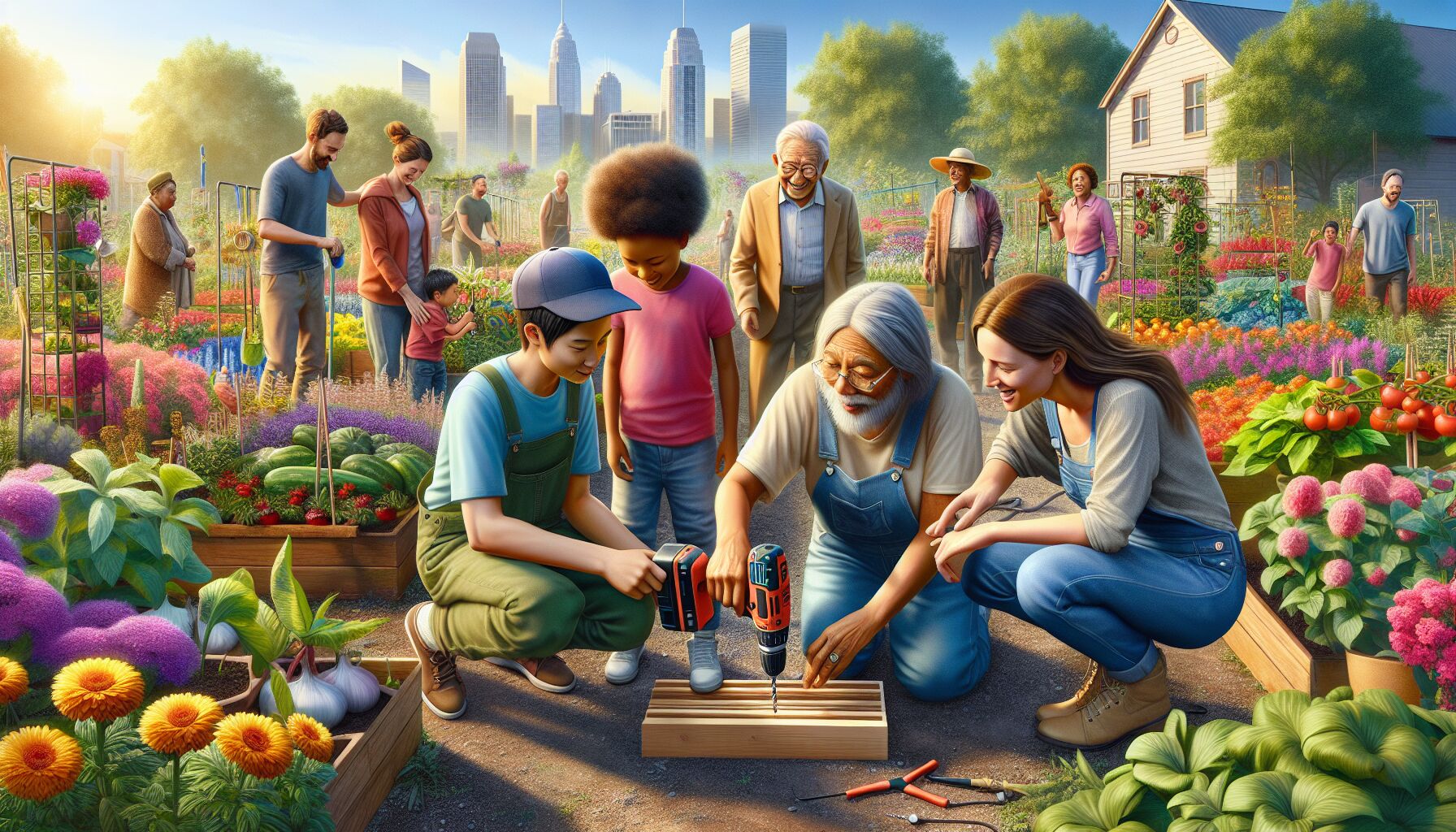 First things first, understanding the heartbeat of your neighborhood is essential when starting a community tool library. You want this endeavor to tether closely to the strings of local needs and aspirations. So, here’s the thing: before you rush off to collect hammers and wrenches, take a moment to look around and really see your community. What do people truly need? Is it gardening tools for their urban plots, or perhaps power tools for shared DIY projects? Start with some open conversations. Chat over coffee at local gatherings or send out a quick survey to get a sense of what might empower folks the most.
First things first, understanding the heartbeat of your neighborhood is essential when starting a community tool library. You want this endeavor to tether closely to the strings of local needs and aspirations. So, here’s the thing: before you rush off to collect hammers and wrenches, take a moment to look around and really see your community. What do people truly need? Is it gardening tools for their urban plots, or perhaps power tools for shared DIY projects? Start with some open conversations. Chat over coffee at local gatherings or send out a quick survey to get a sense of what might empower folks the most.
Building a tool library isn’t just about lending tools; it’s about fostering neighborhood resilience through a shared economy ethos. You’re not only curating a collection of practical items but also nurturing a spirit of community sharing. Think about the beauty of a well-worked plot of land where each stroke of the hoe or buzz of the saw is a page in the story of your community. By pinpointing needs, you lay the groundwork for engagement and sustainability. When people see that the library reflects their needs, they’ll naturally be more inclined to participate, contributing their time and resources to the cause.
Now, how do you tap into this community pulse? Begin by mapping out stakeholders — anyone who’ll benefit from or contribute to the library. Schools, local businesses, urban gardeners, and enthusiasts of DIY sustainability can provide insights into what the community truly values. Think about reaching out to these individuals and groups. It’s like gardening: you plant the seeds of conversation, and over time, they blossom into relationships rich with possibilities. Utilize local social media groups or community boards to cast a wider net in gathering opinions.
While you’re at it, remember a line from Margaret Mead, “Never doubt that a small group of thoughtful, committed citizens can change the world; indeed, it’s the only thing that ever has.” Your role is to be the catalyst for this positive change, transforming isolated acts of generosity into a structured system that thrives on reciprocity.
When identifying the needs, consider the season and cycle of community events. Is there a local festival or a maker’s fair that would be the perfect venue for showcasing your idea? Timing can sometimes be as essential as the tools themselves. In unearthing these hidden needs, you’re not just starting a project; you’re starting a ripple that could change how your neighborhood lives, works, and plays together.
Moreover, engage the gatekeepers — those individuals who are already active and respected voices within your community. They can be influential allies in advocating for the tool library. Building trust and partnerships with these folks can turn a simple tool-sharing initiative into a communal revolution — a shared backyard naturally nurturing a tight-knit community.
Once you’ve aligned your vision with the community’s pulse, you’ve got a clear path forward. You’re not just meeting needs; you’re creating connections. The echoes of the hammer on the nail are your signal — a sign that you’re not just sharing tools, but laying down the foundation for a community that thrives on unity, cooperation, and mutual growth.
Sourcing and organizing tools
Creating a robust tool library hinges on carefully sourcing and organizing the tools you’ll offer. We’ve already talked about connecting with your community — now it’s time to fill those shelves with the essentials everyone needs. Think of it as stocking a pantry, but instead of pasta and spices, you’re looking at saws and spades.
So, where do you start? The answer probably lies closer than you think. Reach out first to your neighbors; ask if they have tools they’d be willing to donate. Many folks have a spare hammer or a drill tucked away, barely seeing the light of day. You might be surprised at how many are eager to contribute to a cause that reflects their collective values.
Next, consider local businesses or hardware stores. Establish collaborations with them, perhaps even arranging a sponsorship. In return, offer to acknowledge their contributions in your community newsletters or during local events. These businesses often see the value in supporting community sharing initiatives, and many are willing to offer discounts on bulk purchases or donations for tax benefits.
Donations can be unpredictable in quantity and quality, so plan to supplement what you receive. Make a list of must-have tools and prioritize acquiring them. Start with the basics — think hammers, wrenches, garden tools, and power drills. Then, as demand grows, you can diversify with specialized equipment, serving broader DIY sustainability projects within your community. It’s like building a garden: plant what the soil demands first, then expand with exotic blooms as curiosity and competence grow.
Organizing your tools efficiently is the next hurdle. Here, a bit of methodical thinking goes a long way. You’ll want a system that’s intuitive yet flexible. Perhaps begin by categorizing tools by their primary use: gardening, construction, repair, etc. Label clearly and create a simple check-out process. A digital system might be your best choice for ease and efficiency; there are free software options available designed specifically for libraries, like “LibraryThing” or “TinyCat”. But even a shared spreadsheet can work wonders if you’re starting small.
Remember those dialogues from before? Keep them ongoing. Feedback loops are crucial. Ask users what helps them and what doesn’t — they’re your eyes on the ground. These insights are invaluable for tweaking your organizational methods and ensuring a seamless experience for borrowers.
Now, let’s sprinkle in a bit of soul here. This isn’t just about tools or systems; it’s about crafting an environment of neighborhood resilience. Each borrowed tool, each shared experience seeds a deeper connection to your land and each other. It’s like that quote from Buckminster Fuller, “You never change things by fighting the existing reality; to change something, build a new model that makes the existing model obsolete.” You’re not just changing the way folks borrow tools — you’re enriching how they live together, one hammer or hoe at a time.
Your journey doesn’t stop once the library is stocked and organized. Maintain that spirit of continual growth and learning. Tools, like knowledge, wear out, and both require regular tending to keep them sharp and useful. Budget for maintenance and consider workshops on proper use and basic repairs, drawing in more community members and fostering DIY sustainability. Through these efforts, your library becomes not just a repository but a vibrant hub of learning and collaboration, enriching your community with skills and bonds that endure.
Promoting and engaging the community
 Community initiatives like a tool library thrive when they ignite passion and interaction. So, how do you stir that excitement and keep the flame burning? It’s a bit like throwing a party. You send out invites, set the mood, and keep everyone chatting. Begin with a launch event — nothing grandiose, but enough to grab attention. This isn’t just about free snacks and speeches; it’s a chance for people to see what’s possible when tools and goodwill come together. Invite local DIY enthusiasts and friendly neighborhood faces who might be curious. Sometimes, the universe aligns just so, allowing a single event to sprout connections and interest that ripple through the community.
Community initiatives like a tool library thrive when they ignite passion and interaction. So, how do you stir that excitement and keep the flame burning? It’s a bit like throwing a party. You send out invites, set the mood, and keep everyone chatting. Begin with a launch event — nothing grandiose, but enough to grab attention. This isn’t just about free snacks and speeches; it’s a chance for people to see what’s possible when tools and goodwill come together. Invite local DIY enthusiasts and friendly neighborhood faces who might be curious. Sometimes, the universe aligns just so, allowing a single event to sprout connections and interest that ripple through the community.
But it doesn’t stop there. Keeping people engaged is where the magic lies — and where it often eludes. Leverage storytelling; share tales of projects completed thanks to your tool library. Perhaps the Robinsons built a birdhouse last weekend, or maybe Maria finally tackled her overgrown garden. Highlight these stories through social media or a newsletter.
Social media acts as a modern town crier. Use it to build a virtual community, with posts showcasing borrowed tool successes and upcoming projects that invite group efforts. How about a community garden day or a fix-it fest where folks gather to tackle those pesky home repairs together? These events create and reinforce neighborhood resilience — more than just lending tools, it’s crafting spaces where people learn, laugh, and labor side by side.
Speaking of community sharing, it’s vital to remember not everyone likes scrolling Facebook or Instagram. Old-school methods like flyers on community bulletin boards still work wonders — a tangible reminder of what’s growing in their backyard. Plus, don’t underestimate word-of-mouth from those gatekeepers we talked about earlier. Their endorsement isn’t just a clap on the back; it’s a green light to others that gives the library credibility and appeal.
And then there are workshops — gems in the rough of community engagement. Host simple sessions on tool safety or basic DIY tricks. Imagine a Saturday where all ages gather to learn how to use a drill properly or how to assemble a raised planter box. Knowledge like this transcends the immediate utility, seeding an enduring culture of DIY sustainability that blooms long after the hammers are stowed away.
Engagement is a two-way street. Keep your ear to the ground, listening for what folks love and what they wish would change. Feedback loops transform your library from static to dynamic, ensuring it stays relevant and useful. Maybe someone suggests a partnership with local schools to provide tools for educational projects. Why not?
In this endeavor, you’re akin to a gardener who doesn’t just plant seeds but tends to the whole plot, ensuring each sprout receives what’s needed to thrive. Community sharing fosters neighborhoods where tools aren’t just instruments of task completion — they’re keys unlocking potential, resilience, and unity in equal measure. And isn’t that something worth promoting?
 DS Haven In Light Of Things
DS Haven In Light Of Things





